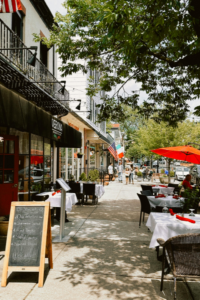Restaurant Marketing: The Ultimate Guide to Attracting and Retaining Customers
In today’s digital age, restaurant marketing isn’t just a nice-to-have – it’s essential. Diners increasingly rely on online information to decide where to eat. In fact, a recent survey found that 77% of diners check a restaurant’s website before visiting, and around 90% of people look up a restaurant online (whether on search engines, maps, or review sites) before ever stepping in the door. This means whether you run a cozy independent café or manage a large restaurant chain, your online presence and marketing strategies can make the difference between a packed house and empty tables.
Effective restaurant marketing helps you stand out from the competition, reach new customers, and keep loyal patrons coming back for more. In this comprehensive guide, we’ll explore key facets of restaurant marketing – from local SEO and social media to email campaigns and data analytics – and show how each aspect works together to boost your restaurant’s success. Let’s dive in!
Local SEO for Restaurants

Local SEO (Search Engine Optimization) is all about making your restaurant visible to hungry customers in your area. When someone searches for “best brunch near me” or “Italian restaurant in [Your City],” you want your establishment to show up at the top of the results. Why? Because Google is often the first place diners look for restaurants. Moreover, “near me” searches for eateries have exploded in recent years, highlighting how crucial local intent is in restaurant discovery.
To harness local SEO, start by claiming and optimizing your Google Business Profile with up-to-date info, menus, and mouth-watering photos. Encourage patrons to leave positive reviews on sites like Yelp or TripAdvisor. Also, ensure your website includes your location, contact info, and relevant keywords (e.g., “authentic sushi in [City]”) so search engines can index your pages properly. Local SEO efforts help your restaurant appear prominently on Google Maps and local search results, driving foot traffic and reservations. For a deeper dive into tactics that will get your restaurant discovered by nearby diners, check out our Local SEO for Restaurants: A Comprehensive Guide to Being Found .
The Power of Social Media Marketing

In the restaurant world, social media marketing is like modern word-of-mouth on steroids. Platforms like Instagram, Facebook, and TikTok let you showcase your delicious dishes, ambiance, and specials to a broad audience. It’s an engagement goldmine: diners love to share food photos and tag their location, effectively doing your marketing for you.
Being active on social media helps your restaurant stay top-of-mind. Post drool-worthy images of menu items, behind-the-scenes kitchen moments, and customer testimonials. Encourage guests to tag your restaurant or use your branded hashtag. Consider that contests and limited-time offers can go viral — for example, “Free dessert if you share this post” promotions. By leveraging social platforms, you not only attract new customers but also engage your local community and build a loyal following. Learn more about crafting an impactful social strategy in The Power of Social Media Marketing for Restaurants .
Email Marketing 101: Building a Loyal Customer Base

While social media may grab headlines, email marketing is a tried-and-true channel that delivers serious results—especially for retaining customers. Building an email list of your diners (through loyalty programs, reservation systems, or Wi-Fi sign-ups) gives you a direct line to people who already love your food.
Use email to keep your customers engaged and coming back. Send out a weekly or monthly newsletter with updates: new menu items, holiday specials, upcoming events, or chef’s recipes. Personalization helps—segment your list and tailor messages to your audience. By consistently reaching out with value (not spam), you stay on your customers’ minds and increase the chances they’ll choose you next time they dine out. For tips on building a restaurant mailing list or crafting compelling campaigns, see Email Marketing 101: Building a Loyal Customer Base for Your Restaurant .
Data-Driven Marketing: Tracking & Measuring Restaurant Success

Successful restaurant marketing isn’t just about creativity; it’s about data-driven decisions. With tools like Google Analytics for your website, social media insights, and POS systems, you can collect valuable data on customer behavior. Tracking key metrics lets you see what’s working and where to invest your marketing budget.
Monitor your website traffic sources (search, social, referral), track email open rates and click-throughs, and note which promotions drive in-store visits or orders. By understanding these patterns, you can double down on what works and refine or drop the tactics that don’t. Data also enables personalization: if you know a segment of customers dines with you on weekends, you might target them with a “Sunday Brunch” deal. To learn more about tracking the right metrics, check out Data-Driven Marketing: Tracking & Measuring Restaurant Success .
Boost Restaurant Visibility with Multilingual Menus and Global Appeal

If your restaurant is in a multicultural city or tourist hotspot, multilingual menus can be a game-changer. Offering content in multiple languages makes your establishment more welcoming to travelers and non-native speakers, expanding your potential customer base.
From an SEO standpoint, catering to multiple languages can help you appear in search results in other languages, too. Beyond that, it showcases inclusivity, helping you stand out as a tourist-friendly spot. Implementing multilingual menus can be as simple as using a plugin or a digital menu solution. For more tips on making your restaurant accessible to a global audience, see Boost Restaurant Visibility with Multilingual Menus and Global Appeal .
From First-Time Diners to Regulars: Retention Strategies That Work

Getting new customers is great, but turning them into loyal regulars is even better. Loyal customers provide steady business, spend more, and refer friends. The key to retention is consistently delivering excellent food and service, plus implementing a loyalty program or rewards-based system.
Consider special promotions or member-only perks, and don’t forget about personal touches—like remembering a regular’s name or favorite dish. Regularly engage with your audience via email and social media, showing appreciation and responding to feedback. For a detailed look at effective retention tactics, check out From First-Time Diners to Regulars: Retention Strategies That Work .
How Easy Menus Solves These Challenges

We’ve covered a lot of ground—local SEO, social media, email, data, multilingual content, and retention. You might be thinking, “That’s a lot to juggle!” This is where Easy Menus (easymenus.eu) comes in as an ideal solution. Easy Menus is a digital menu and website platform designed specifically for restaurants, offering features that directly support the strategies we’ve discussed:
- Effortless Menu Creation: Craft and update your menu in minutes—no coding skills needed.
- Multilingual Support (16 languages): Welcome tourists and diverse communities with high-quality translated menus.
- Real-Time Updates: Change menu items or prices instantly, from anywhere.
- Performance Optimization: Speed-optimized and mobile-friendly design—crucial for user experience and SEO.
- Customizable Themes: Match your restaurant’s brand and aesthetic for a consistent online presence.
- SEO-Friendly Structure: Built with clean HTML and best practices, helping you rank higher in search results.
- Dedicated Support: Get help whenever you need it, so you can focus on serving great food.
By integrating Easy Menus, you centralize your menu management while enhancing your marketing reach—an up-to-date, SEO-friendly, and multilingual menu ties perfectly into your social media, email, and local search efforts.
Conclusion & Call to Action
Restaurant marketing covers everything from local SEO to social media and data analytics, but it all boils down to one main goal: attracting diners and keeping them coming back. The good news is that you don’t have to do it all alone. Tools like Easy Menus are specifically designed to make these tasks easier—freeing you to focus on what you do best: serving fantastic food and creating memorable dining experiences. Ready to take your restaurant’s marketing to the next level? Check out Easy Menus today, and toast to a future of fully booked tables and growing revenue!



